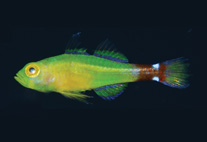Abstract
Three new species of Trimma are described from various localities in Indonesia. All three can be readily identified from their live, freshly collected, or preserved colouration. Trimma meranyx n. sp. is further distinguished from other species by the possession of 8–9 scales in the predorsal midline, up to three rows of (usually) cycloid scales on the opercle, two scales at the posterodorsal border of the cheek, a very slightly elongate second dorsal spine which only just reaches the spine or anterior rays of the second dorsal fin, unbranched pectoral fin rays, a fifth pelvic fin ray that branches once and is 64–85% the length of the fourth ray, and a full basal membrane connecting the inner branches of the two fifth pelvic rays. The dark red (live) or black posterior half of the caudal peduncle with large white spots straddling the dorsal and ventral midlines just anterior to the first procurrent caudal fin rays is the diagnostic colour character. The species is known from North Sulawesi, West Papua (Raja Ampat and Fakfak), and the south-eastern tip of Papua New Guinea, with possible records from the Philippines and Vanuatu. Trimma pajama n. sp. has 6 scales in the predorsal midline, two ctenoid scales along the dorsal margin of the opercle, a slightly elongate second dorsal spine reaching posteriorly to the base of the spine or first ray of the second dorsal fin, unbranched pectoral fin rays, a fifth pelvic ray with a single branch point and which is 58–72% the length of the fourth ray, and a full basal membrane connecting the inner branches of the two fifth pelvic rays. The live, freshly collected and preserved colour pattern of alternating dark and light stripes on the head and most of the body (except the posterior half of the caudal peduncle) is diagnostic. It is currently known from West Papua (Raja Ampat and Fakfak) and the southern tip of Papua New Guinea, with possible records from Kalimantan (Indonesia), Palau, the Hermit Is (Papua New Guinea) and the Solomon Islands. Trimma zurae n. sp. has 8–9 scales in the predorsal midline, usually a single row of cycloid scales along the upper border of the opercle, 11 anterior and 9 posterior transverse scale rows, no elongated spines in the first dorsal fin, 9 dorsal and 8 anal fin rays, the middle rays of the pectoral fin branched, a single branch in the fifth pelvic fin ray which is 65–76% the length of the fourth ray and a reduced basal membrane of < 20% the length of the fifth ray. The eye-diameter sized black ocellated spot between the first to fifth spines of the first dorsal fin is diagnostic, as are the pupil-diameter sized orange spots on the nape, opercle and posterodorsal part of the cheek. It is currently known only from a single locality just west of Manado, Sulawesi.

